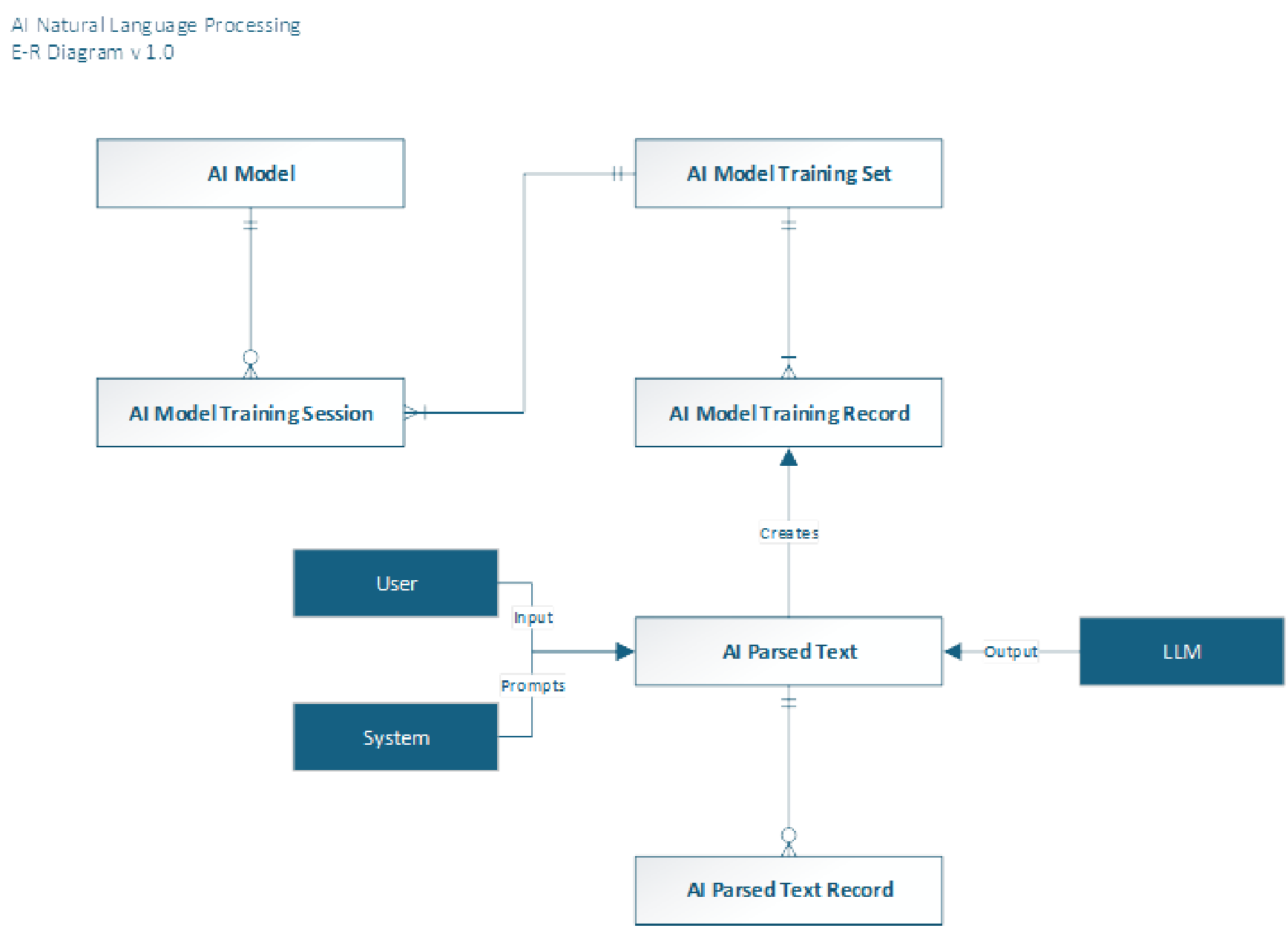Automatically create Load and Truck Postings from customer emails with Artimus™ AI.
Contact a Revenova representative for pricing information.
Setup
Complete the following setup steps to use Artimus™ AI.
Enter Credentials
Enable the integration with OpenAI by completing the following steps:
Navigate to TMS Admin.
Select Credentials.
Select the Global Services tab.
Find OpenAI in the list and open the card.
Check the Enabled box.
Enter Revenova in the User ID text field.
Enter the provided password into the Password 1 text field.
Click the Save button when finished.
Valid credentials are provided by Revenova. The User ID and Password 1 are required fields.
User ID | Password 1 | Password 2 | Customer Number |
|---|---|---|---|
Revenova | API Key (provided by Revenova) |
Remote Site Settings
Check the Remote Site Settings when upgrading from a previous TMS release. Verify they match the Service and Test Service URLs provided. If the Remote Sites do not exist, create them following the steps below.
Click the Setup gear icon in the top right corner.
From the drop-down, click Setup.
In the Quick Find Toolbar type Remote Site Settings and click the link.
From the list of remote sites find OpenAI. Confirm the Remote Site URL is: https://api.openai.com.
If no Remote Site exists, create it for the Service URL.
Click the New Remote Site button.
Enter OpenAI_Service into the Remote Site Name box.
Enter https://api.openai.com into the Remote Site URL box.
Confirm Active is Checked.
Click Save.
If no Remote Site exists, create it for the Test URL.
Click the New Remote Site button.
Enter OpenAI_Test into the Remote Site Name box.
Enter https://api.openai.com into the Remote Site URL box.
Confirm Active is Checked.
Click Save.
Service URL: https://api.openai.com
Test Service URL: https://api.openai.com
Create Email Services
Create an Email Service to receive and process customer email requests. Load and Truck Postings each require their own individual Email Service.
Navigate to Setup and search for Custom Code and select Email Services.

Choose the New Email Service button.
Name the Email Service according to the record type to process. The example below is named “Loads.”
Click the search icon to select the appropriate Apex Class.
Load emails are processed by the LoadEmailHandler class.
Truck Posting emails are processed by the TruckPostingEmailHandler class.
Check the Active box.
Click Save.
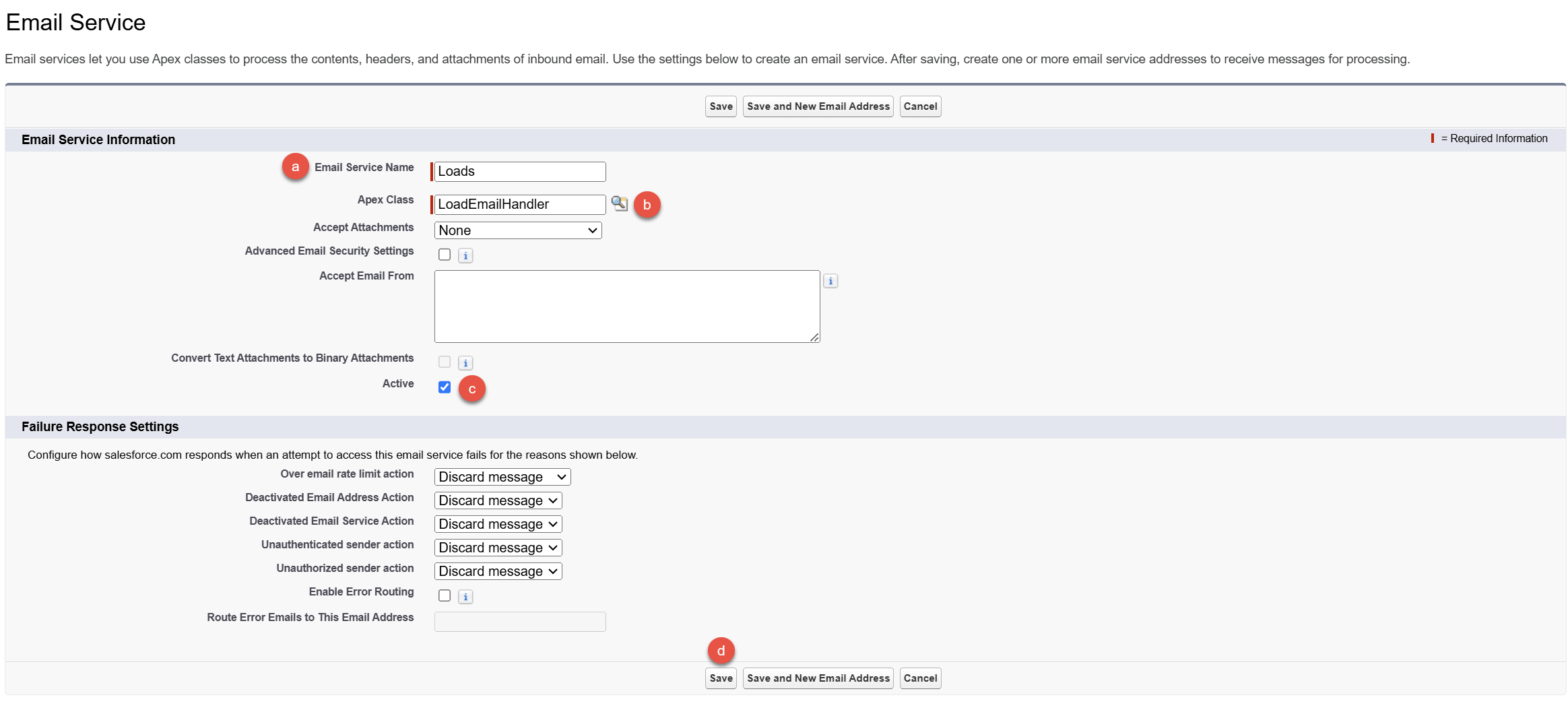
In the Email Addresses section, click the New Email Address button.
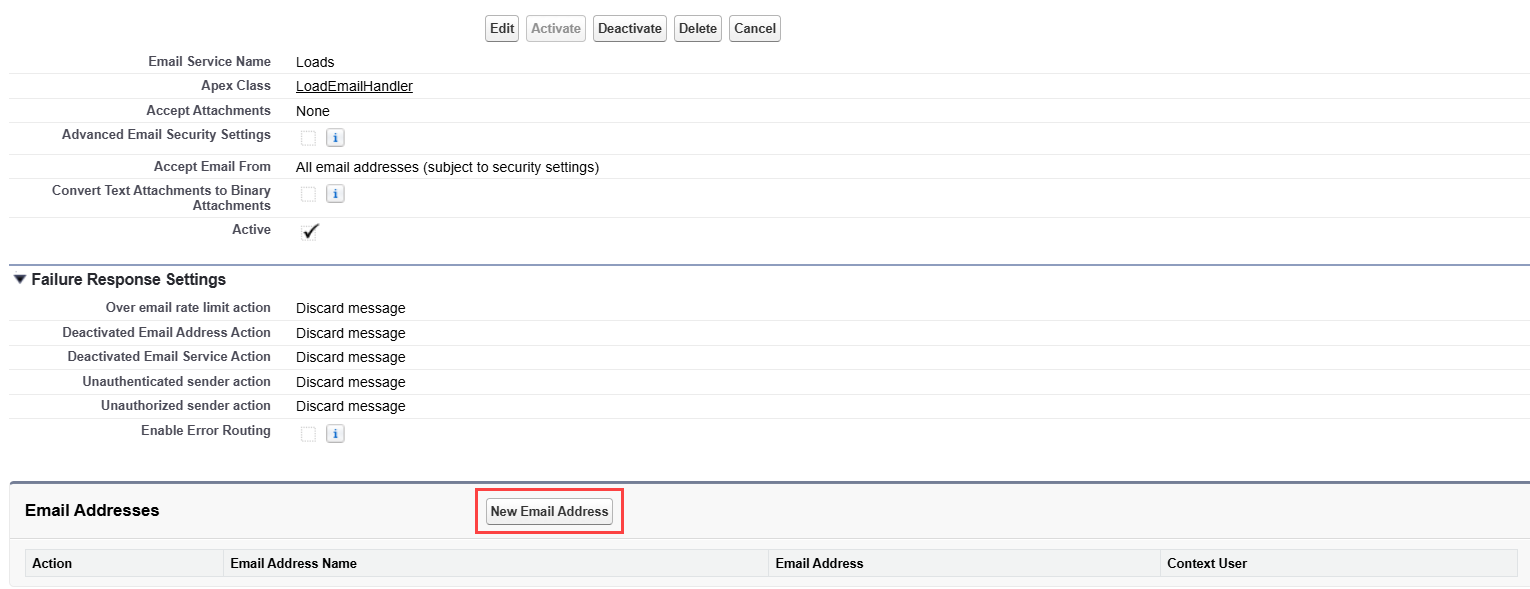
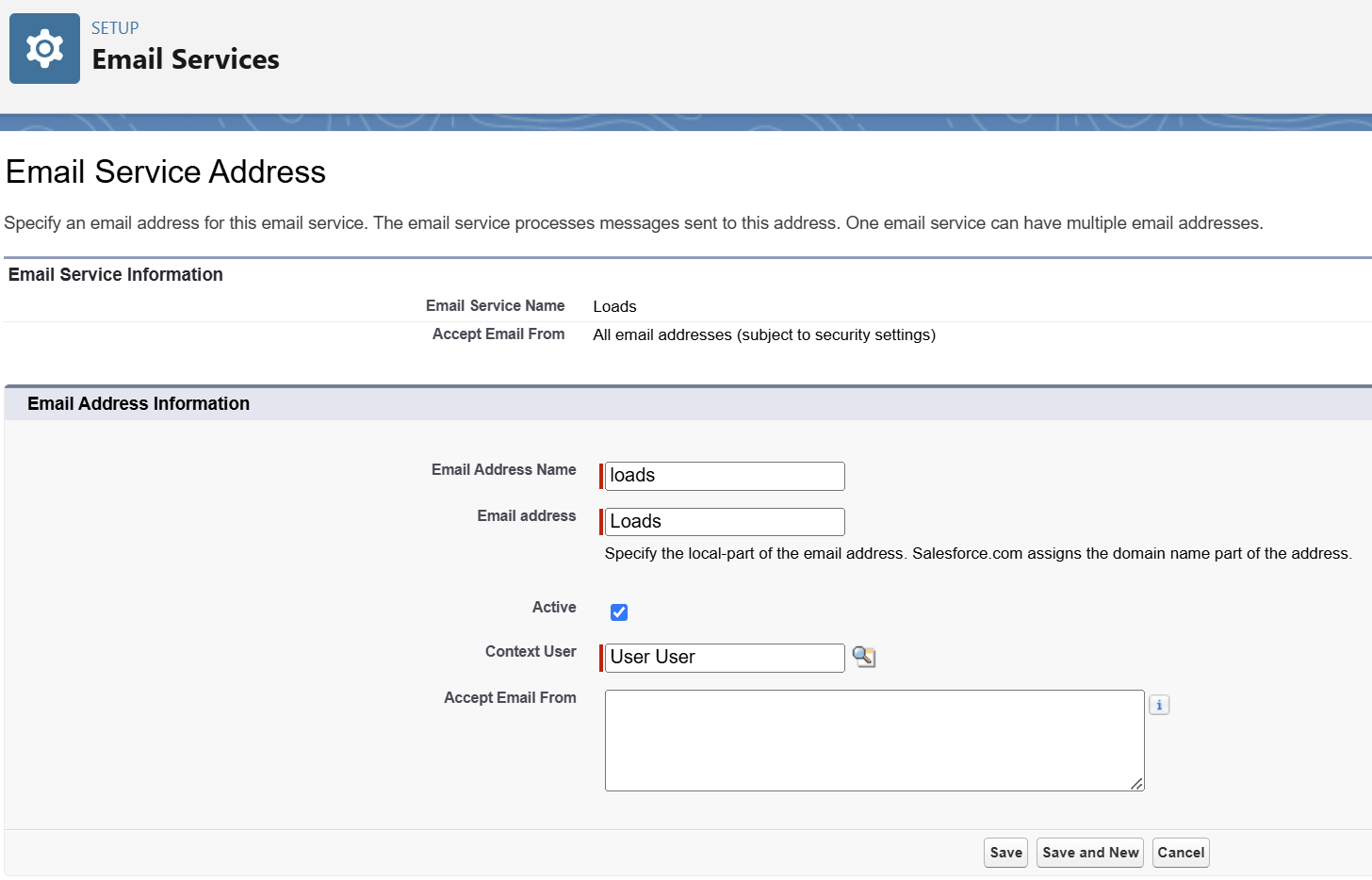
Enter an Email Address Name (loads is shown above).
Delete the value in the Email Address field and enter loads.
Check the Active box.
Delete everything in the Accept Email From field.
Click Save.
Salesforce creates and adds the domain to the end of the Email Address field.
Provide the generated email address to customers for them to send email submissions. Emails received at this address are processed to create Load (or Truck Posting) records by Artimus™ AI.
Email Address domains are generated by Salesforce to be lengthy as a security measure. The email domain cannot be changed.
.png)
Complete the setup again for Truck Postings replacing Loads with Truck Postings.


Inbound Emails
From the App Launcher, search for Inbound Emails to view any emails that were not sent for processing. When errors are corrected, the email message must be re-sent to attempt to process again.
Email attachments are not processed. Only the subject and the body of the email are processed in the Artimus™ AI request.
Errors are displayed in the list view with additional detail.
Common errors may include, “This email is not associated with any account.,” “There is no AI Model selected for use on the AI Console configuration popup.,” and others.
Customers or Carriers attempting to email Artimus™ AI to create a Load or Truck Posting must have a Contact record associated with an Account. That Contact must include the address they are emailing from.
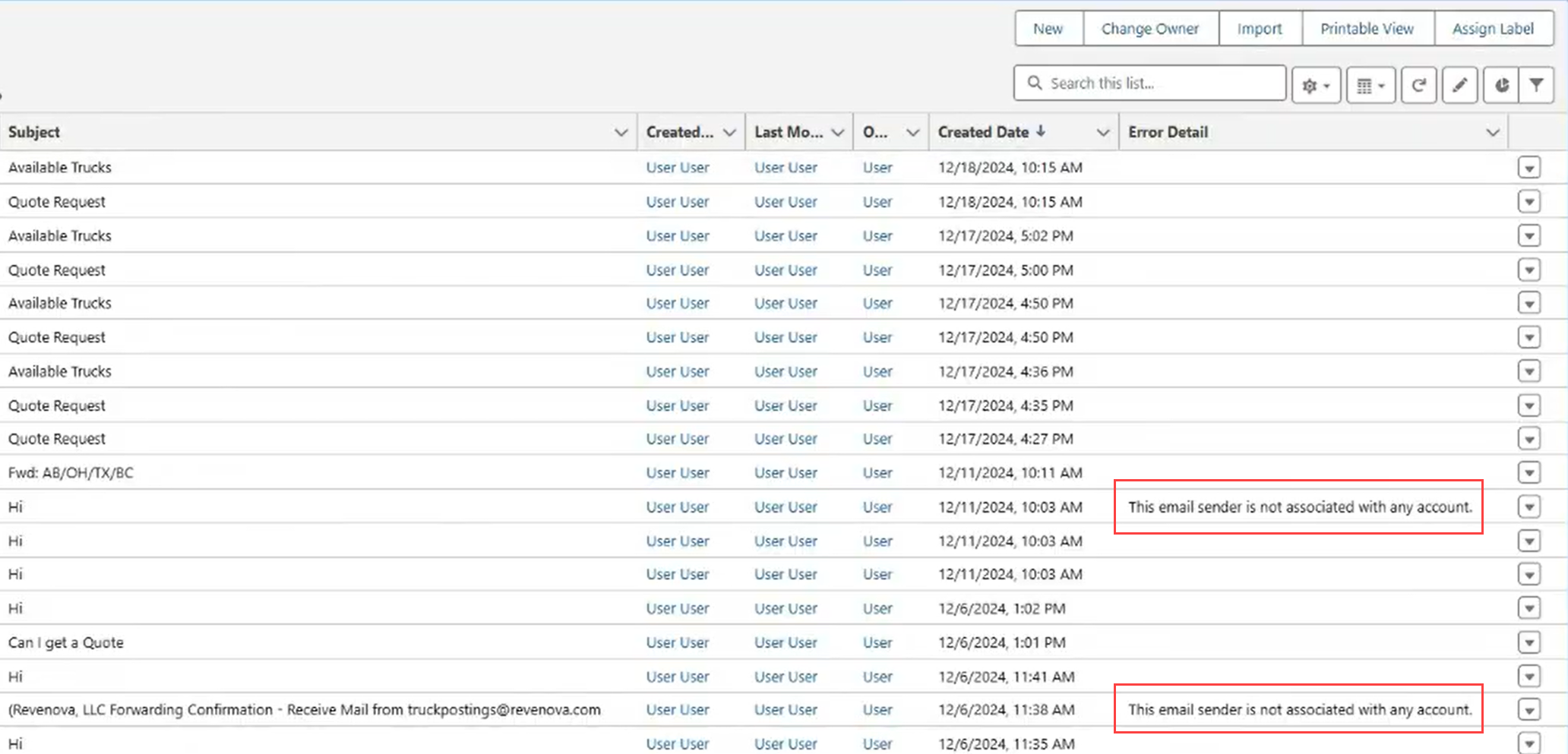
If no AI model is selected, navigate to the AI Console and click the Configuration button. Select an AI Model and Save to begin processing email messages.
Additional Setup
Navigate to TMS Admin → Modes and Check the AI Enabled box to include those mode types when generating Load and Truck Postings. Only include modes that are specific to the customer business needs.
When generating Load and Truck Postings the AI language model makes a “best guess” to determine the Mode based on the enabled Mode types. Select the fewest Mode types as necessary.
Add the Text to Load and/or Text to Truck Posting modals to the desired pages or to the utility bar.
The Transportation Profile AI Generated Customer Quote Status field controls when a customer quote is automatically sent to a customer. If an email requesting a Load quote meets the threshold required to create a Load and matches a customer-stored rate entry, then the customer quote is sent to the customer via the email loop. The quote Status is either Accepted or Quoted depending on the picklist value set on the Transportation Profile.
Instead of automatically setting the customer quote Status to Accepted, the AI Generated Customer Quote Status field allows for setting the Status to Quoted for Loads generated with Artimus™ AI.
Add the AI Created Load LWC to the Load Lightning Record Page (or custom Load LRP). The Revenova default Load Lightning Record Page only displays the component when a Load is AI generated. For upgrade installations, add the following component visibility filters when adding the LWC to a Lightning Record Page. These filters allow for only showing the LWC for AI-generated Loads.
Record > AI Generated Equal true
Record > Load Status Equal Unassigned
Record > Load Status Equal Quotes Requested
Record > Load Status Equal Quotes Received
Record > Load Status Equal Cancelled
Record > Load Status Equal Expired
Show component when: The filter logic is met:
Filter logic: 1 AND (2 OR 3 OR 4 OR 5 OR 6)
Add fields to the Load TMS3 as needed. This controls which fields are displayed in the AI Created Load LWC and the AI Console under the Created Records section.
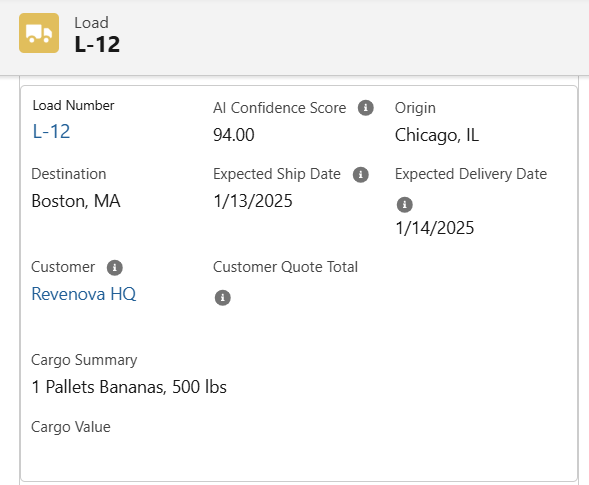
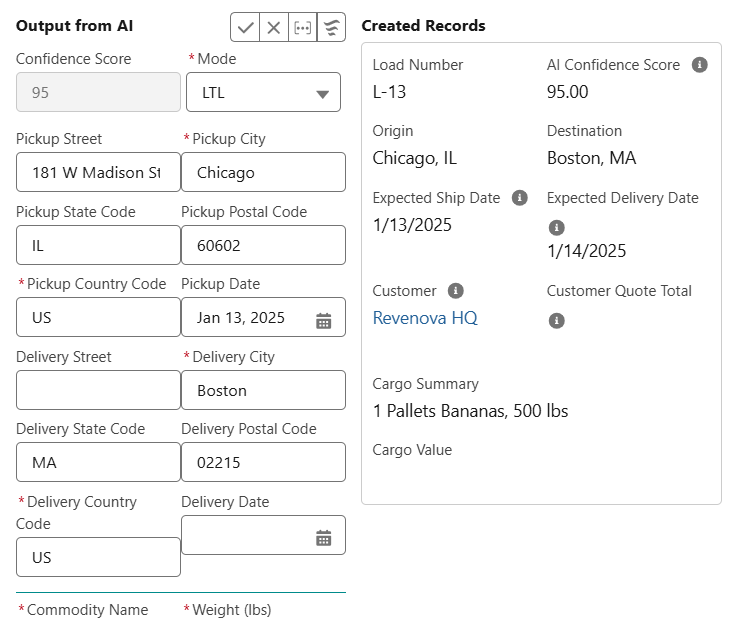
Add fields to the Truck Posting TMS2 field sets as needed. These field sets control which fields are displayed in the AI Console under the Created Records section.
An AI Model must be selected (provided models) or created (new models) with threshold settings in place to begin processing requests with Artimus™ AI.
Run the Queued Transaction job or confirm the job is running to send customer quotes as they are generated.
AI Console
Administer and configure the use of Artimus™ AI from the AI Console. Search the App Launcher and select AI Console.
The following actions may be completed from the AI Console.
Filter and sort requests and responses from OpenAI based on the following criteria.
Filter by record creation status.
Filter by record type.
Filter by date and time.
Create or delete Load and Truck Postings based on the results from AI.
Review and update fields.
Train custom AI Models based on results returned from OpenAI.

Click the Configuration icon
 in the banner to set threshold values for each AI Model.
in the banner to set threshold values for each AI Model.Select the AI Model and enter the 3 threshold values: AI Load Creation, AI Customer Quote Creation, and AI Truck Posting Creation.
These thresholds are compared to the confidence scores available for each record.
If the confidence score is greater than the threshold, the corresponding record is created.
The confidence score represents a “best guess” that the text input from either an email or from one of the modals was correctly identified. For emails containing incorrect data, the “correct” result is to not create a record.In general, the AI Customer Quote threshold should likely be highest. Followed by the AI Load creation, and then the AI Truck Posting.
View the number of AI Transactions and AI Training Transactions licensed, used, and remaining.
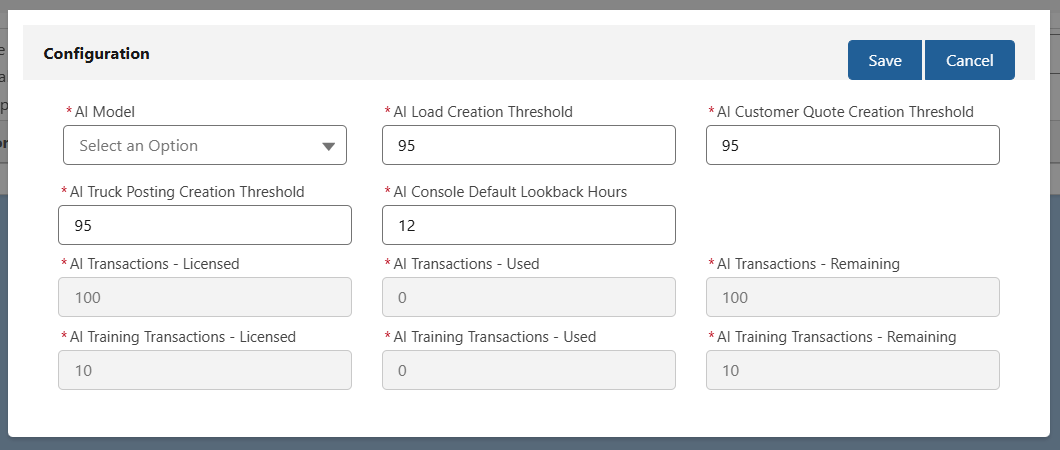
Select individual records in the AI console to view record information and the confidence score.
.png)
Review and correct Load or Truck Posting records as necessary to train a custom AI Model.
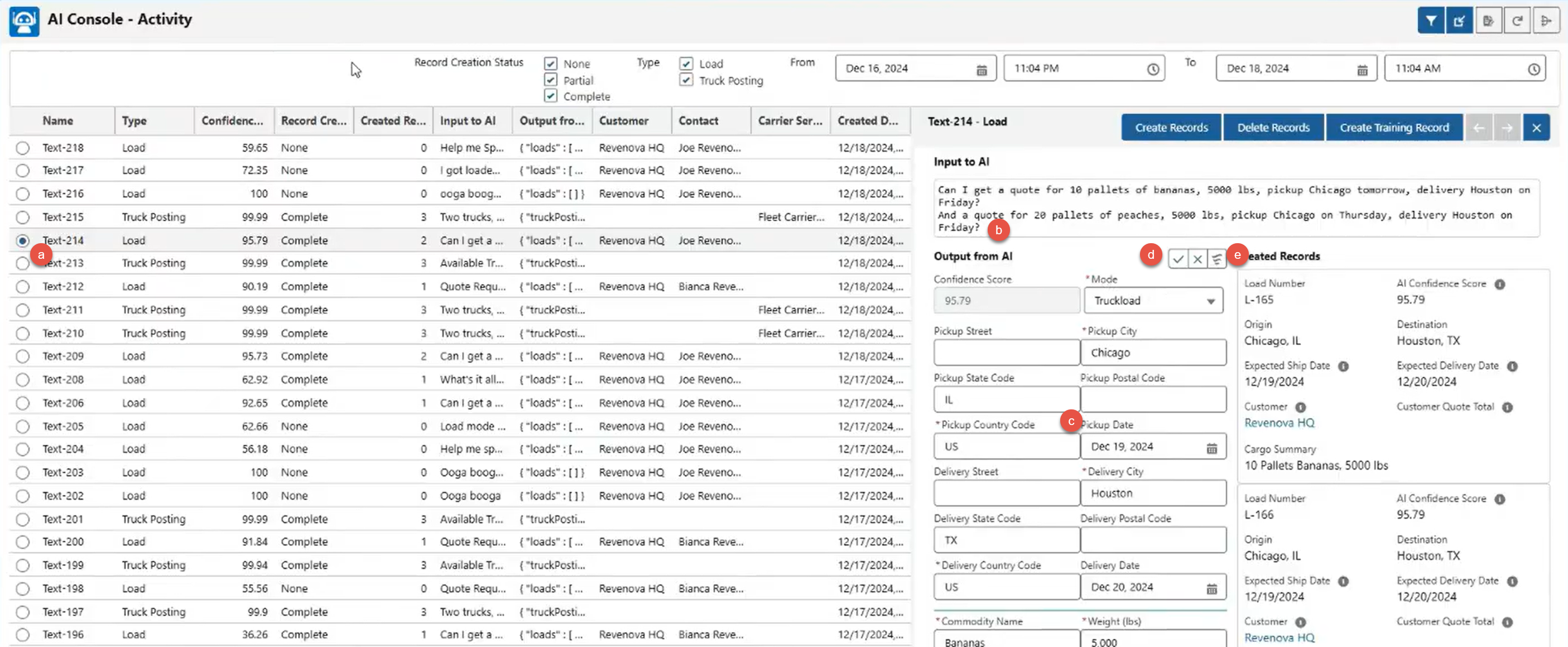
Select a Load or Truck Posting record from the AI Console activity section.
View the input sent to the AI to generate the record.
In the output form AI section, view returned field values.
Update any values that returned incorrectly.
Click the Save button to keep any field changes.
View the JSON payload returned from the AI.
Multiple Load or Truck Postings may be created from one AI request.
Once fields are updated and corrected as necessary, click the Create Records button to generate the Load or Truck Posting.
The AI Model can return “hallucinations” based on the input received. In these cases the records can be removed.
Click the Delete Records button to remove these records.
Modals
Text to Load Modal
Add the Text to Load modal to the home page or another page as desired. The Text to Load modal allows users to enter Load details for a customer and automatically generate the Load and customer quote with Artimus™ AI.
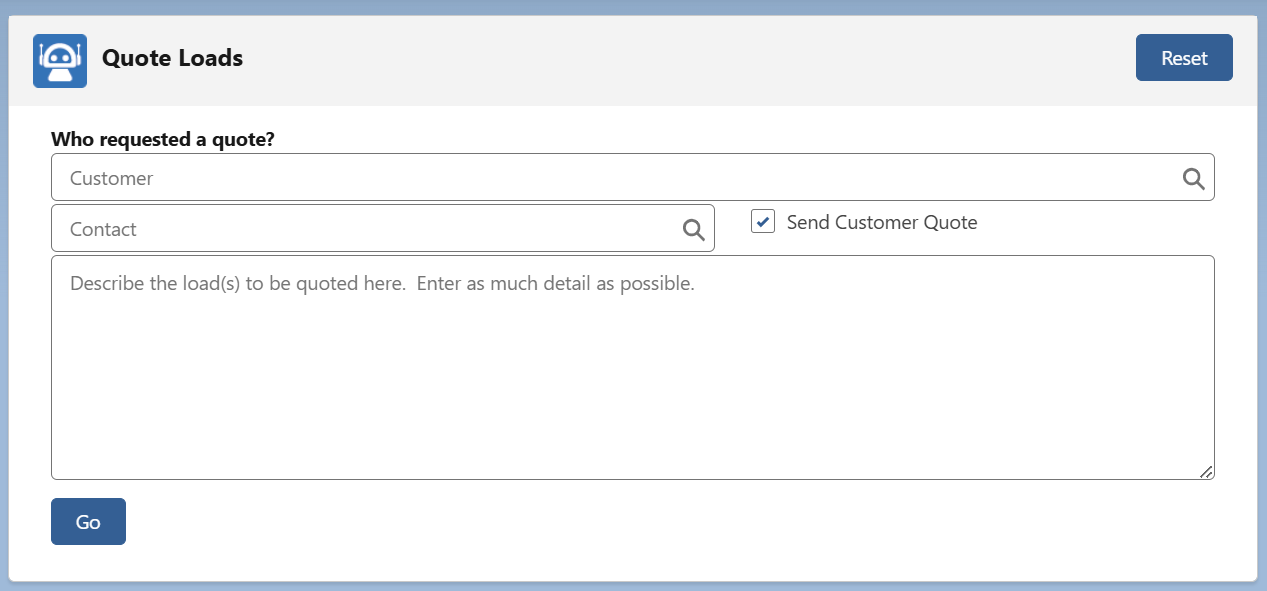
Search for and select the customer account in the box.
Enter the customer Contact in the second box.
Automatically send the generated customer quote when the Send Customer Quote box is Checked. The Queued Transaction Job must be running for the email containing the quote to send to the customer. The TMS attempts to match Customer Rate Entries with the Load details and the best matching Rate Entry is used for the quote sent to the customer.
Enter a detailed description of the Load including origin and destination information, line items, and any other Load information.
Click Go to generate the Load record.
When Artimus™ AI processes the request, the results are available for review in the AI Console.
Field Reference
The following fields are processed by Artimus™ AI. Additional Load fields are not created based on the text entry from the Quote modal or received emails.
Line Item
Handling Units
HazMat
HU Count
Item Description
NMFC Class
Weight (Lbs only)
Load
Expected Delivery Date
Expected Ship Date
Mode
Stop
Address
City
Country
Postal Code
State/Province
Account Stops are not created through Artimus™ AI.
Text to Truck Posting Modal
Add the Text to Truck Posting modal to the home page or another page as desired. The Text to Truck Posting modal allows users to enter Truck Capacity details for a Carrier and automatically generate the Truck Posting record with Artimus™ AI.
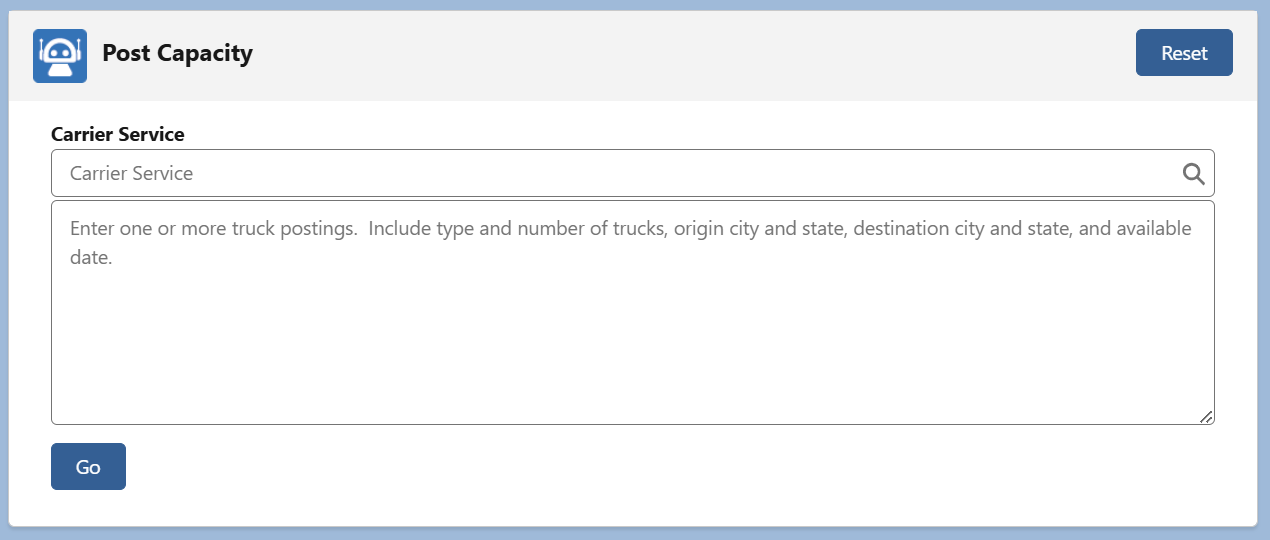
Search for and select the Carrier Service in the box.
In the second box, enter a description of the capacity. Multiple Truck Postings may be entered at once.
Click Go to generate the Truck Posting record(s).
When Artimus™ AI processes the request, the results are available for review in the AI Console.
Field Reference
The following fields are processed by Artimus™ AI. Additional Truck Posting fields are not created based on the text entry from the Post Capacity modal or received emails.
Available Date
Carrier Name
Destination City
Destination Country
Destination State
MC Number
Number of Trucks
Origin City
Origin Country
Origin State
Truck Type
US DOT Number
Carrier Service Matching
If no Carrier Service record is selected in the Text to Truck Posting modal, the TMS attempts to match to an existing Carrier Service record. At each step, LTL-only Carriers are removed to only match Carriers with the appropriate Carrier Service type. The order below is followed to match to a Carrier Service.
Carrier Service ID
MC Number
USDOT Number
Carrier Name
Contact Email
The related Account is selected.
Matched to a Carrier Service.
AI Created Load LWC
The AI Created Load LWC is available on the Load page layout for Loads created with Artimus™ AI. The input is provided to confirm the Load fields are correct.
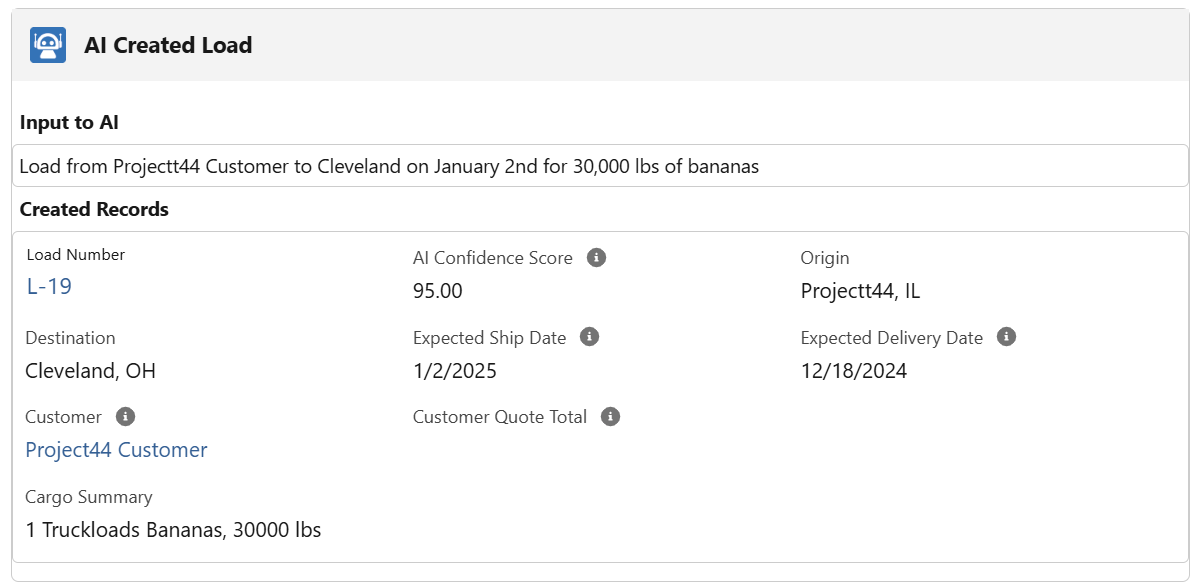
.png)
Training AI Models
Create and train custom AI Models to return better results when generating Load and Truck Postings.
Train new models based on customer email requests and user submitted requests from the Text to Load and Text to Truck Posting modals.
The Summer ‘25 TMS release includes support for the gpt-4.1 and gpt-4.1-mini AI models. These models are more efficient than previous versions. Use these new models or create new custom models.
Create an AI Model
Custom AI Models are generated from existing gtp-4.1 and gpt-4.1-mini models and trained on returned Load and Truck Posting records from the AI. Currently, a custom AI Model cannot be trained multiple times. A new model must be created and trained off of an existing model (including custom models).
From the AI Console, choose the Model Training icon
 to view the training console.
to view the training console.Click the plus icon in the AI Models section.
Enter a Model Name and search for the Parent Model. Typically, the Parent Model is gpt-4.1 or gpt-4.1-mini.
The gpt-4.1 model typically returns better results, but takes more time to finish. The gpt-4.1-mini returns results more quickly, but may not be as accurate.
Check the Enabled box. Only enabled models may be used.
Check the Is Custom Model box.
All User created models are custom models.
Click Save.
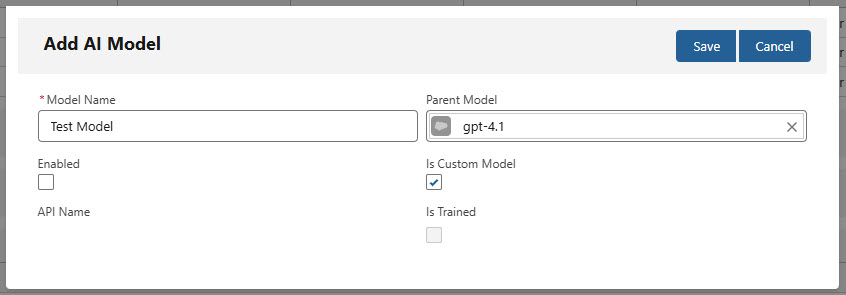

Create Training Sets
Create AI Model Training Set(s) to train the AI Model. Training Sets consist of AI Model Training records.
Training records are created from the output generated by AI. Review the output and correct any fields before creating training records.
Create a Training Set record by clicking the Plus icon to open the modal.

In the modal, enter a name and optional description for the AI Model Training Set.
Return to the AI Console.
Review and correct Load or Truck Posting records as necessary to train a custom AI Model.

Select a Load or Truck Posting record from the AI Console activity section.
View the input sent to the AI to generate the record.
In the output form AI section, view returned field values.
Update any values that returned incorrectly.
Click the Save button to keep any field changes.
View the JSON payload returned from the AI.
Click the Create Training Record button to open the modal.
.png)
Select the Training Set to add the Training Record to it. Click the Create button.
Create additional Training Records and add them to the Training Set.
Training Sets should consist of approximately 10 to 200 Training Records.
When the AI Model Training Set is selected, the records are displayed in the Console below.

View Training Set information with the Edit button.

The Edit Training Set modal allows for changing the Training Set name or adding a description. The available buttons complete the following actions.
Preview
Upload
Save
Clone
Cancel

View the information included in the Training Set with the Preview button. Each Training record added to the Training Set is displayed in the preview. If any records require changes, return to the individual record and update fields as necessary.
Only “correct” Load or Truck Posting records should be used in Training Sets.
.png)
Click the Upload button to send the Training Set.

Click Save to keep any changes and return to the AI Console. Select Clone to create a copy of an existing Training Set. Choose Cancel to discard any changes and return to the AI Console.
Conduct Training Session
To use a Training Set, it must first be sent to OpenAI. Click the Upload button. The Upload Status appears in the AI Console as Uploaded when the Training Set is successfully received.
A single Training Set may be used to train multiple AI Models.
When the Training Set is uploaded, conduct a Training Session.
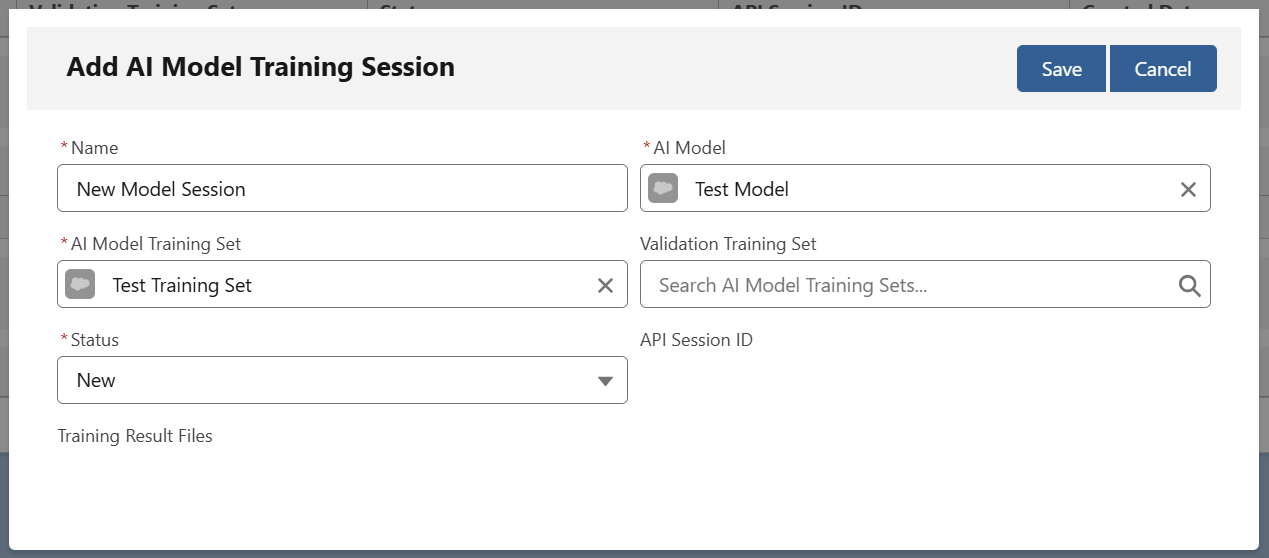
Create a new AI Model Training Session.
Select the AI Model Training Set and a Validation Training Set. The Training Set makes changes to the AI Model and the Validation Training Set verifies that those changes are correct.
A Validation Training Set is not required but is recommended.
Click Save to create the AI Model Training Session record and return to the AI Console.
Select the AI Model to train. The AI Model Training Session appears on the Console. Click the Edit icon to view the record.
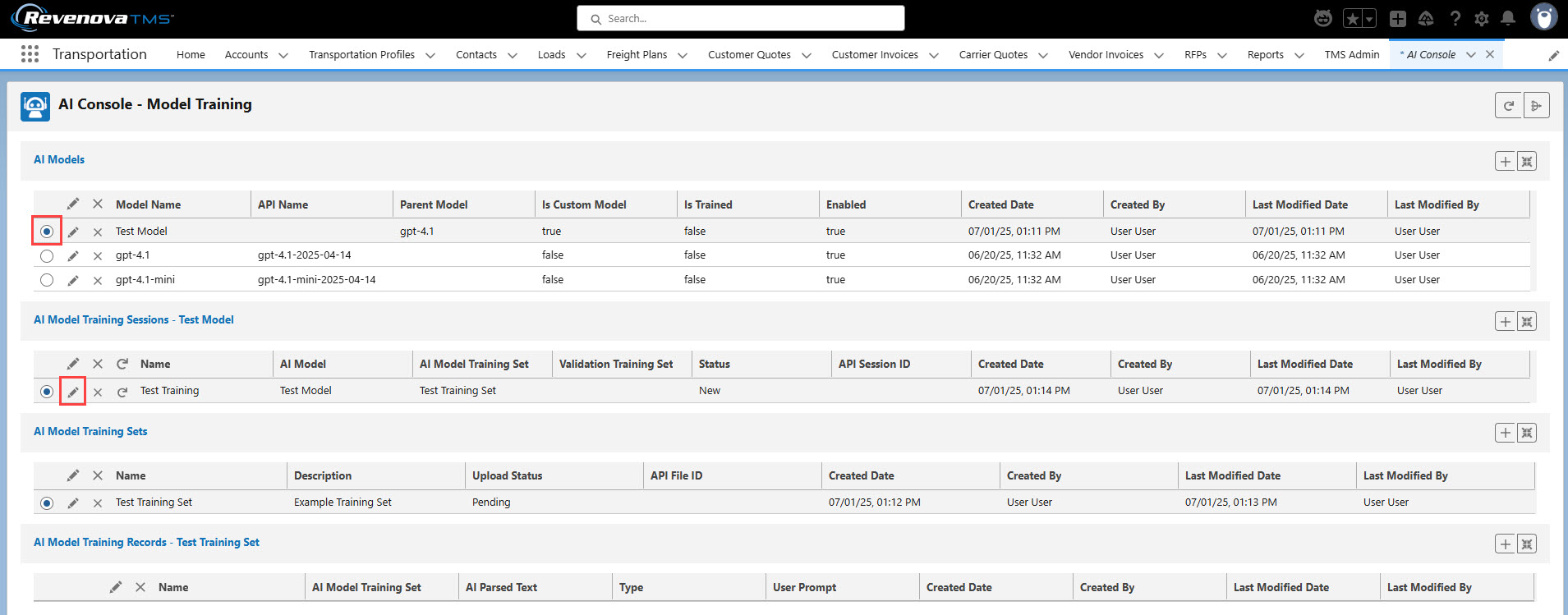
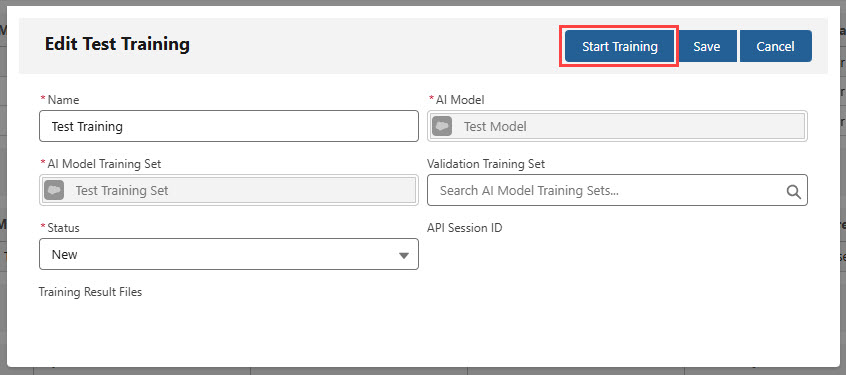
Click the Start Training button.
View the current Status of the Training Session from the AI Console.

Use the Refresh button on the AI Console to view the latest status update.

Training an AI Model may take several minutes.
When the Training Session completes successfully, the newly-trained AI Model may be used to create Load and Truck Posting records.
Return to the Activity screen of the AI Console.
Click the Configuration button in the banner.
Select the new model from the AI Model picklist.
Click Save.
Data Model
